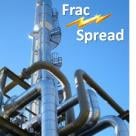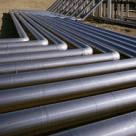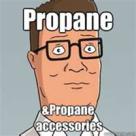Growing propane production from the NGL surge is building up inventories and pushing down prices because it can’t reach markets where demand is increasing. That story probably sounds familiar to crude and natural gas producers actively looking for opportunities to export their way around production overhangs. However, unlike crude and natural gas (or condensate) there are no regulatory barriers to prevent US propane exports. Today we look at how exports will balance growing supplies in the propane market.
Daily Energy Blog
Natural gas processing plants are being built or expanded at a feverish pace. At least 90 projects are in the works around the U.S., expected to add more than 15 Bcf/d of capacity according to the latest Bentek NGL Facilities Databank numbers. How do the economics of these investments work? We know that it is a lot more complicated than a simple frac spread. But does that mean the calculations must be exclusively the purview of engineers armed with gas plant optimization models? Heck no. Anybody, even an MBA with a spreadsheet, a few standard factors and a gas analysis can figure out how a gas processing plant makes money. So to prove that point today we’ll dive one more time into natural gas processing economics to understand how the composition of an inlet gas stream is converted to outlet streams of natural gas liquids and residue gas.
NGL production in the Marcellus is growing by leaps and bounds. There is only one play projected to grow faster – Utica. And Utica sits just a few thousand feet below the Marcellus. Combined NGL production from the two plays is projected to range between 450 – 600 Mb/d depending on who’s forecast you like best. But as fast as these volumes are coming on, natural gas processing capacity and fractionation capacity are being expanded even faster. Are the midstreamers getting ahead of the producers with 22 gas plant projects and 11 new fractionators or expansions in the works? Or do these midstreamers know something that is not baked into the various industry production forecasts? Let’s see what the most recent projections are telling us.
Over the next five years, production of natural gas liquids (NGL’s) from gas processing plants will increase by at least one million barrels per day, or about 40% over 2012. Perhaps more. That’s good news for natural gas producers, processors and end-use markets. But there is a catch. The rate of production does not match up with demand. While production is a steady, “ratable” volume, demand is anything but ratable. Demand swings with petchem feedstock economics, the gasoline blending season, weather and a myriad of other factors. The flywheel that balances supply and demand on any given day is storage. But not just any storage. For NGLs, storage of large volumes means salt caverns. Huge caverns thousands of feet below the surface. In this NGL storage blog series starting today, we’ll look at the history of NGL salt storage, where it exists, how it is used, and where more of it is needed. In this first installment we’ll go all the way back to the origin of NGL salt storage. All the way back to Smoky Billue.
The NYMEX New York October gasoline contract expired last Friday at $3.34/Gal, up 13 percent during the week from $2.91/Gal last Monday (September 24, 2012). In contrast the November contract closed 42 cents lower than October on Friday at $2.92/Gal. The sudden jump in October New York gasoline prices during the last week of trading was caused by severe supply problems in the Northeast US. This week new cargoes en-route to New York have calmed market fears but the disruptions look set to repeat in a tightly balanced market. Today we investigate what happened.
Next time you fill up with regular; spare a thought for what the product went through to make it into your tank. Before you got a chance to put the pedal to the metal, the tiger in your tank had to treat a digestive problem that was causing too much gas. It was all in honor of something called Reid Vapor Pressure (RVP) regulations. Today we open the window on the issue to air the pungent details.
|
Check out Kyle Cooper’s weekly view of natural gas markets at |
RVP stands for "Reid Vapor Pressure" a measure of gasoline volatility indicated in pounds per square inch (PSI) at 100 degrees Fahrenheit. The higher a gasoline's RVP the more quickly it evaporates. The RVP for gasoline should always be below normal atmospheric pressure or 14.7 PSI. If the RVP gets higher than 14.7-PSI fuel might evaporate in the gas tank on a hot day resulting in a vapor locked engine (car won’t start) or worse yet, an explosion. At the same time you need a certain RVP level in the winter when it gets cold or your car won’t start because the fuel won’t vaporize in the carburetor.
Unlike pipelines that take a long time to build and only deliver to a handful of destinations, rail freight cars offer the flexibility to deliver anywhere across North America. The rail freight industry can load, store and transport different NGLs (including those NGL products that must be transported under high pressure) as well as crude and petroleum products. Rail infrastructure is mostly already in place so new routes can easily be brought on line. That’s why rail freight has been used successfully by the energy industry for over 100 years as - a “pipeline on wheels”. Today we look at the rail tank car business for moving NGL and petroleum products.
The West Coast natural gas liquids (NGL) market is an island unto itself. Unlike the world east of the Rockies where pipelines link together producing and consuming regions, the West Coast NGL market is marooned except for rail tank cars and a few waterborne cargos. It is a fiercely independent market with its own unique players playing their own ballgame. But like the rest of the NGL world, big changes are rippling through that market. Today we begin a series looking at those changes and how West Coast NGLs are likely to evolve over the next few years.
NGL prices have been weak this year, but the same has been true for the price of natural gas. So how does this market scenario play out for gas processors who make their money extracting NGLs from gas? Last week we looked at what could be gleaned from the Frac Spread, and concluded that it missed a couple of key variables like the liquids content and the BTU value of the inlet gas. So today we’ll see what it takes to incorporate those factors into our analysis and in the process dive deep into the math of gas processing to learn about things like cubic feet, GPM and moles.
2012 has not been a good year for natural gas liquids prices. Spring was a particularly brutal season, with prices falling to levels not seen since the bad ole days of 2009. This summer prices have recovered from late-June lows, but the numbers are still in the dog house relative to the past couple of years. Although this is hardly something that sprung up overnight, lately it seems like there has been a rash of hand wringing by analysts, rating agencies and not a few companies warning about the consequences for midstream businesses and NGL producers. Our friends at Tudor Pickering called it a ‘Blood Bath’. Is it really that bad? Our blog series in March called 2012 the ‘Golden Age’ of gas processors. Have we gone from a Golden Age to a Blood Bath in six months? It seems like it’s time for another deep dive into gas processing and NGL production.
This week when nominations come to mind your thoughts naturally go to the political candidates in general, and the Tampa convention in particular. But don't forget about that other kind of nomination - the most important step in the scheduling of NGLs and other hydrocarbon transportation. Today we will continue our blog series on the Art of NGL Distribution by examining exactly how the nomination step takes place. We’ll continue the scenario covered last week in Movin’ Down the Line – Conway Propane to Janesville, WI on MAPL. That’s a nomination from Kansas, so we thought a politically themed title would be appropriate.
It’s still August, but there already is crispness in the Wisconsin mornings. And to a propaner, that’s a signal that the heating season is on its way. It is time to get those supplies lined out, and to make sure that customers are ready for the winter. But Wisconsin is a long way from the centers of propane supply. How does the propane get there? How do the Distribution experts make sure the right volumes are in the right place at the right time? In today’s blog we’ll continue our exploration of the Art of NGL Distribution by digging into the mechanics of moving supply on the Enterprise Mid-America Pipeline (“MAPL”) system from the Conway, KS hub to the Wisconsin market. Along the way we’ll learn how propane is scheduled on a pipeline system, how a NGL pipeline tariff works, and why the word “allocation” sends shivers down the spine of an NGL shipper.
We’ve talked here frequently about the two ends of the Natural Gas Liquids market. On one end we have the commercial aspects of the business – things like pricing, differentials, processing economics and feedstock selection calculations. At the other end, there is the operational infrastructure – processing plants, pipelines, fractionators and downstream demand, including olefin plants. You may have wondered – what ties the commercial and operational worlds together? In the NGL world, the answer is Distribution – often the unsung hero of the NGL marketplace. Where the rubber meets the road. Where deal-making is translated into reality. Today we start a series of blogs to examine why NGL distribution is so important to the market, how it works, how Distribution generates value and why it is much an art as it is a science.
The Gnats Patootie
NGLs are complicated. First of all, there are five different products included under this umbrella: ethane, propane, normal butane, isobutane and natural gasoline. Each has different physical characteristics and different markets. With the exception of natural gasoline, all of the NGLs require high pressure and very low temperatures to move in a liquid state. All are highly flammable, heavier than air and require special handling all across the value chain – things like processing, fractionation, high pressure pipelines, insulated trucks rail cars, and salt dome storage. The total cost of all of this frequently can add up quickly, running over $0.20/gallon or $8/barrel, and occasionally much higher. It seems mind boggling, and for an amateur it can be.
The good news is there are many talented people behind the scenes working to ensure this is done well and efficiently. They live and breathe in a world filled with jargon terms like pump tickets, tenders, tariffs, fuel adjustments, product losses, pipeline allocations, product specs, late fees, component balancing, Product Transfer Orders (PTO’s), Bill of Ladings (BOLs), Freight on Board (FOB), demurrage, pumpovers, batch orders, stenched, unstenched, and the list goes on. It is a world that does not stop at 5pm. Product is moving 24 hours a day, 7 days a week. Most of the time things go right. But sometime things go wrong – mechanical failures, process upsets, product handling errors, and worse. All of these issues must be handled in a timely, methodical and professional basis. At the end of the day, all the paperwork (or databases, these days) must reconcile down to a gnats patootie. That’s a much tighter specification than six sigma.
The folks that inhabit this world are the Distribution experts – who can make or break the economics for NGL transactions. The job is Distribution. And the process is mysterious, critical, and truly an art—an art in which the big midstream players make big investments.
Is it just scheduling product from place to place? No, it’s a long way from that. The process involves understanding and actively engaging in every part of the NGL’s life from production to end use (like y-grade and propane in the Long and Winding Road Part I & Part II) and squeezing out every bit of value possible; down to a small fraction of a cent. It requires understanding the operations of production forecasting, gathering, gas processing and pipelines operations, high pressure tank cars, trucks, waterborne ships and barges, loading docks, fractionation, storage – salt caverns and above ground bullets, PTO’s (product transfer orders), computer technology, and cash flow.
The Art and Magic of NGL Distribution
But the Distribution expert must know more than the physical hardware. Infrastructure knowledge must be combined with a solid understanding of contract terms/flexibility, market intuition, and negotiating skills. It is truly an art to pull all of this together in a distribution plan that can be effectively and profitably executed. But that is still not enough. This knowledge must be combined with the talent and skill to develop great, dependable and valuable relationships with other people in the Distribution fraternity. It is these relationships that make the “magic” of this process happen. Some of the best in the industry have been doing this their whole career and are truly masters.
Companies who are serious about making money on NGL’s invest in the best and brightest to do Distribution for them. The large companies have Distribution experts for each product and each piece of the road. Others have experts handling larger pieces or the entire journey.
So what do most of these Distribution experts do? Just think, every time an NGL molecule changes location or changes hands a long chain of activities takes place. Each movement must be subject to a contract between the parties. Each transaction must be measured, reconciled and ultimately financially settled. Frequently (but not always) the triggering event for the physical movement of product is scheduling. That activity makes up a big part of the Distribution function, and it is a perfect place to start our journey.
Scheduling NGLs: Introducing Scenario #1
In “The Long and Winding Road”…we followed the journey of a molecule of propane from producing well to end-use market, which was a relatively typical journey. In the background of that story there were a minimum of 7 scheduling points, requiring at least 14 schedulers, tons of technology, phone calls, emails, spreadsheets, and lots of very high (human) energy. If that journey hadn’t been so smooth, those numbers (and Advil consumption) would be on the rise. Rarely does it go that smooth. Let’s look at some other typical winding road scenarios and do a deeper dive into exactly what NGL scheduling is all about.
“A Midwest NGL Company” (“AMNGLCo”) is a large midstream company that owns NGL assets and owns or controls production all over the US and Canada. Propane expertise has been the foundation for their success and a staple product for decades. They own it, buy it, sell it, transport it, store it, speculate on it, and build assets around it. Similar to other large midstream companies, distribution and scheduling is centralized in their home office, in this case located in Gotham City, Oklahoma. Those experts work via phone and e-mail with the “field” operations (considered all the people who physically make and move NGL’s) out and around the continent. This is an example of a company that understands the complexity and importance of Distribution and has the process down pat.
Here is just one (of many) scenarios that AMNGLCo could face every day.
“Keep (us) Dry!!!”
On Friday purity ethane in Mont Belvieu came in at 36.4 cnts/gal on OPIS, up 1.5 cnts while Conway ethane in E/P mix was up 1.25 cnts to 15.75 cnts/gal. Given that at this time last month Conway was trading at a dismal 2.25 ctns/gal while Mont Belvieu was wallowing under 30 cnts/gal, these numbers sound pretty good (See Chart #1 below). But let’s not lose sight of the fact that these prices are still dirt cheap. This time last year ethane prices were 2.5X to 3X higher. Is this simply a replay of the natural gas-oversupply-price-collapse story as some are saying? Or is it more complicated than that? As you’ve probably guessed, it is definitely more complicated than that. Because this the simplest of the NGL molecules turns out to be surprisingly complex in the marketplace. Today we’ll break down that complexity by looking at the details of the ethane markets.
On June 1st, Mont Belvieu propane non-TET fell to 70 cnts/gal from about 150 cnts/gal six months earlier, down more than 50%. See Graph #1 below. But over the past couple of weeks the propane price has rebounded. On Friday the OPIS propane number was up to 89.4. Have we hit bottom for the time being? What makes propane prices move the way they do in the first place? Today we’ll continue last Friday’s blog series that covered trading and pricing of natural gasoline, normal butane and isobutane with a deep dive into the same issues for the most famous of the NGLs – propane.








